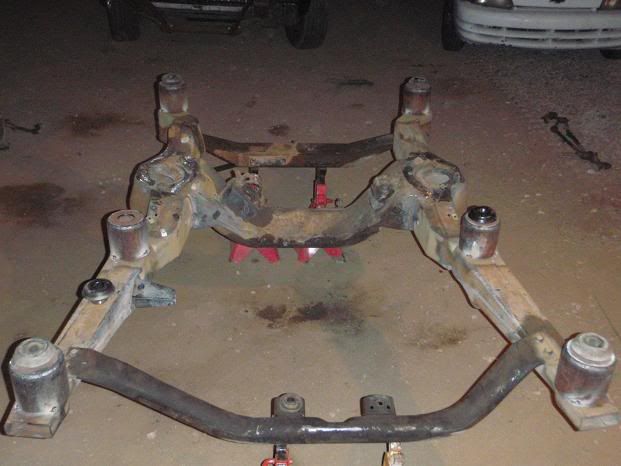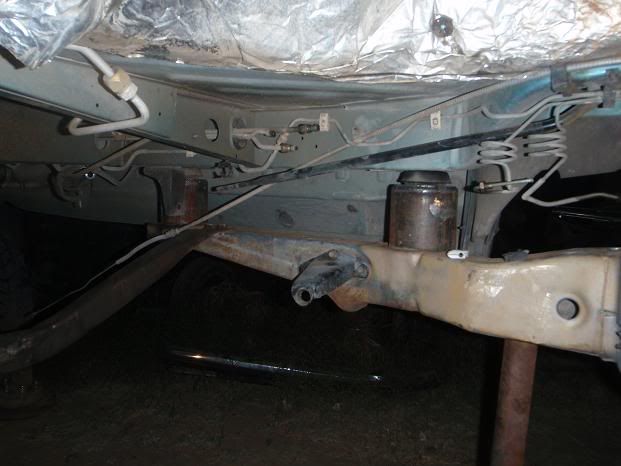The van developed a fuel leak that was dumping raw fuel into the engine valley, which flowed nicely down the back of the motor, through the drain holes and into the bell housing and out the bottom through the inspection cover. It started a couple weeks ago with a drip here & there & slight hint of raw diesel fuel smell, and progressed up to the end of this week with a 6" diameter wet spot & very strong fuel smell constantly. The doghouse was pulled and pooled fuel could be seen in the engine valley, but as things are so cramped it could not be determined where it was coming from. A call was placed to one of my suppliers to order a fuel pump, and to dieselorings.com to get all of the o-rings, banjo bolt gaskets and fuel short blue fuel lines to replace everything that could potentially leak in the fuel bowl, lines, and valley. I also added Fumoto oil drain valve to the order from Bob at Dieselorings.com to make future maintenance easier. I had one on the F250 and really liked the ease of draining the oil without removing the drain plug, and it never leaked.
So yesterday I enlisted Vince at work to lead the charge on the fuel system because I had never tackled anything of this complexity needing to finish in one day. It took both of us from 9:30 am to 8:53pm to finish the job, with breaks for lunch and dinner. Off the back the turbo, the y-pipe up tubes and plumbing were removed, followed by the fuel pump. Up front the alternator, pulley block and air intake assembly with filters and hoses were removed to gain access to the fuel bowl feed lines. Then the fuel bowl was removed from the rear and everything assessed for cause. The fuel pump was wet, as was the sensor coming off the side of the fuel pressure regulator (which I found out commonly leaks and should be replaced when tearing onto the fuel system like this) and the banjo bolt was wet that holds the line splitter that feed fuel from the fuel bowl to the injector banks at the rear of each cylinder head. There was raw fuel pooled on the top of the engine valley so that was cleaned off, and the bottom hose from the pump to fuel bowl was in really bad shape. I opted for the better flourosilicone mil-spec o-rings for the fuel bowl because I only wanted to have to do this job once, and the new ULSD (ultra low sulfur diesel) fuel is much harder on the factory o-rings.. The entire kit, including the Fumoto valve and turbo pedestal o-rings was $70 shipped. The pump was $78 my cost (retails at about $120), lunch & dinner was about $38 for both of us, and I'm paying Vince for his time and very valuable work and knowledge. I had a copy of the Ford FSM on hand for reference, and for those questions not answered in the book, Bob at dieselorings.com said I could call anytime to get help if I needed it. It was amazing to have his expertise a phone call away on a Sunday to help with the job. I strongly recommend him and his company for all of your o-ring needs. Replacing everything on the fuel bowl took about 30 minutes once it was out, and man did it need a thorough cleaning. The inside of the fuel bowl was insanely dirty, the fuel filter was brown, and many of the o-rings looked very beat. The screen on the bypass valve was also caked with crud. The most amazing part of our findings to me was the turbo itself - on one side the housing, between the aluminum body for the impeller and the turbo itself, there are 4 bolts holding the assembly together. Of those 2 were tight, one was backed off 1/16" and spinning freely, and the 4th had backed all the way out and was laying on the pedestal. I'm glad we found and corrected this!
Aside from the regular tools most everyone would have, a 7/8" crows foot socket was needed to remove the center post in the fuel bowl in order to get the heater assembly out and clean everything thoroughly. Having seen it done I could have tackled it myself but it was so involved that I would have not been the same person when finished. Vince lends a level of calm and control to a project that is worth the price of admission. After buttoning everything back together it instantly fired up and ran, rough at first (the fuel bowl was empty after all) and in about a minute it was idling much smoother than it ever had. No raw fuel was detected, so I packed up and headed home. I'm hoping that going out this morning will provide dry ground under the van and a solution to the problem. Again, it was not a difficult job, but very lengthy and involved because of the tight quarters in the compartment (that body lift is sounding better every day). We found and solved other issues that were unknown when we started, and I'm very glad this project is done. Everything we touched should be good to go for at least another 276K miles.


